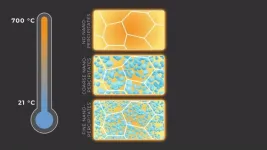(Press-News.org) Scientists at the Department of Energy's Oak Ridge National Laboratory and the University of Tennessee, Knoxville, have found a way to simultaneously increase the strength and ductility of an alloy by introducing tiny precipitates into its matrix and tuning their size and spacing. The precipitates are solids that separate from the metal mixture as the alloy cools. The results, published in the journal Nature, will open new avenues for advancing structural materials.
Ductility is a measure of a material's ability to undergo permanent deformation without breaking. It determines, among other things, how much a material can elongate before fracturing and whether that fracturing will be graceful or catastrophic. The higher the strength and ductility, the tougher the material.
"A holy grail of structural materials has long been, how do you simultaneously enhance strength and ductility?" said Easo George, principal investigator of the study and Governor's Chair for Advanced Alloy Theory and Development at ORNL and UT. "Defeating the strength-ductility trade-off will enable a new generation of lightweight, strong, damage-tolerant materials."
If structural materials could become stronger and more ductile, components of cars, planes, power plants, buildings and bridges could be built using less material. Lighter-weight vehicles would be more energy-efficient to make and operate, and tougher infrastructure would be more resilient.
Co-principal investigator Ying Yang of ORNL conceived and led the Nature study. Guided by computational thermodynamics simulations, she designed and custom-made model alloys with the special ability to undergo a phase transformation from a face-centered cubic, or FCC, to a body-centered cubic, or BCC, crystal structure, driven by changes in either temperature or stress.
"We put nanoprecipitates into a transformable matrix and carefully controlled their attributes, which in turn controlled when and how the matrix transformed," Yang said. "In this material, we intentionally induced the matrix to have the capability to undergo a phase transformation."
The alloy contains four major elements -- iron, nickel, aluminum and titanium -- that form the matrix and precipitates, and three minor elements -- carbon, zirconium and boron -- that limit the size of grains, individual metallic crystals.
The researchers carefully kept the composition of the matrix and the total amount of nanoprecipitates the same in different samples. However, they varied precipitate sizes and spacings by adjusting the processing temperature and time. For comparison, a reference alloy without precipitates but having the same composition as the matrix of the precipitate-containing alloy was also prepared and tested.
"The strength of a material usually depends on how close the precipitates are to each other," George said. "When you make them a few nanometers [billionths of a meter] in size, they can be very closely spaced. The more closely spaced they are, the stronger the material gets."
While nanoprecipitates in conventional alloys can make them super strong, they also make the alloys very brittle. The team's alloy avoids this brittleness because the precipitates perform a second useful function: by spatially constraining the matrix, they prevent it from transforming during a thermal quench, a quick immersion in water that cools the alloy to room temperature. Consequently, the matrix remains in a metastable FCC state. When the alloy is then stretched ("strained"), it progressively transforms from metastable FCC to stable BCC. This phase transformation during straining increases strength while maintaining adequate ductility. In contrast, the alloy without precipitates transforms fully to stable FCC during the thermal quench, which precludes further transformation during straining. As a result, it is both weaker and more brittle than the alloy with precipitates. Together, the complementary mechanisms of conventional precipitation strengthening and deformation-induced transformation increased strength by 20%-90% and elongation by 300%.
"Adding precipitates to block dislocations and make materials ultra-strong is well known," George said. "What is new here is that adjusting the spacing of these precipitates also affects phase transformation propensity, which allows multiple deformation mechanisms to be activated as needed to enhance ductility."
The study also revealed a surprising reversal of the normal strengthening effect of nanoprecipitates: an alloy with coarse, widely spaced precipitates is stronger than the same alloy with fine, closely spaced precipitates. This reversal happens when the nanoprecipitates become so tiny and tightly packed that the phase transformation is essentially shut down during straining of the material, not unlike the transformation suppressed during the thermal quench.
This study relied on complementary techniques performed at DOE Office of Science user facilities at ORNL to characterize the nanoprecipitates and deformation mechanisms. At the Center for Nanophase Materials Sciences, atom probe tomography showed the size, distribution and chemical composition of precipitates, whereas transmission electron microscopy exposed atomistic details of local regions. At the High Flux Isotope Reactor, small-angle neutron scattering quantified the distribution of fine precipitates. And at the Spallation Neutron Source, neutron diffraction probed the phase transformation after different levels of strain.
"This research introduces a new family of structural alloys," Yang said. "Precipitate characteristics and alloy chemistry can be precisely tailored to activate deformation mechanisms exactly when needed to thwart the strength-ductility trade-off."
Next the team will investigate additional factors and deformation mechanisms to identify combinations that could further improve mechanical properties.
It turns out, there is a lot of room for improvement. "Today's structural materials realize but a small fraction -- perhaps only 10% -- of their theoretically capable strengths," George said. "Imagine the weight savings that would be possible in a car or an airplane -- and the consequent energy savings -- if this strength could be doubled or tripled while maintaining adequate ductility."
INFORMATION:
The title of the Nature paper is "Bifunctional nanoprecipitates strengthen and ductilize a medium-entropy alloy."
The DOE Office of Science and ORNL's Laboratory Directed Research and Development Program supported the research.
UT-Battelle manages ORNL for the Department of Energy's Office of Science, the single largest supporter of basic research in the physical sciences in the United States. The Office of Science is working to address some of the most pressing challenges of our time. For more information, please visit energy.gov/science.
Batteries are potentially a game-changing technology as we decarbonize our economy, and their benefits are even greater when shared across communities, a University of Otago-led study has found.
Co-author Associate Professor Michael Jack, Director of the Energy Programme in the Department of Physics, says reducing costs are seeing rapid deployment of batteries for household use, mainly for storing solar and wind power for later use, but they could have a variety of uses in a future electricity grid.
"For example, they could be used to feed energy back into the grid when there is a shortfall in renewable supply. ...
Firearm purchases and firearm violence surged dramatically during the first five months of the COVID-19 pandemic, according to a new study from the UC Davis Violence Prevention Research Program (VPRP), published in Injury Epidemiology.
From March through July 2020, an estimated 4.3 million more background checks for firearm purchases occurred nationwide than would have ordinarily -- an 85 percent increase. The total number of firearm purchases during this period was 9.3 million.
From April through July 2020, there was a 27% increase in interpersonal firearm injuries, which includes firearm homicides or nonfatal firearm assault injuries. This is approximately 4,075 more injuries ...
Eight pieces of salmon-based maki, nigiri or sashimi or maki unagi (eel) is the safest combination of sushi for adult and adolescent populations. That is one of the findings of TecnATox (Centre for Environmental, Food and Toxicological Technology), a joint research group from the URV and the Pere Virgili Health Research Institute (IISPV), which has analysed the presence of arsenic and various heavy metals in sushi. The consumption of sushi has increased significantly since the start of the 21st century, as has the number of restaurants offering it throughout the region. Although eating fish is recommended because of its high nutritional value, it can also lead to exposure to contaminants, such as heavy metals. Likewise, rice is a food that provides many nutrients ...
The rationale for the research is in the fact that despite the high number of recognized Indigenous groups who are struggling to maintain their languages, cultures, and identities in Russia, there is little research done on the matters of cultural and linguistic revitalization. This study sought to address this gap by exploring the views of two Indigenous groups, Karelian and Mari, on the development of their Indigenous languages and educational strategies to protect and revive their languages. The study relied on in-depth one-on-one interviews with 20 participants, ten from each Indigenous group.
The findings show that despite older generations' relative proficiency and interest in their respective Indigenous languages, motivation to master them is ...
ATLANTA - JULY 8, 2021 - Overall cancer death rates continue to decline in men and women for all racial and ethnic groups in the United States, according to the latest Annual Report to the Nation on the Status of Cancer. During 2001 to 2018, declines in lung cancer death rates accelerated, and death rates for melanoma declined considerably in more recent years, reflecting a substantial increase in survival for metastatic melanoma. However, the report finds that for several other major cancers, including prostate, colorectal and female breast cancers, previous declining trends in death rates slowed or disappeared.
The report, appearing in JNCI: The Journal of the National Cancer Institute, also finds that overall cancer incidence ...
Tooth loss is a risk factor for cognitive impairment and dementia--and with each tooth lost, the risk of cognitive decline grows, according to a new analysis led by researchers at NYU Rory Meyers College of Nursing and published in JAMDA: The Journal of Post-Acute and Long-Term Care Medicine. However, this risk was not significant among older adults with dentures, suggesting that timely treatment with dentures may protect against cognitive decline.
About one in six adults aged 65 or older have lost all of their teeth, according to the Centers for Disease Control and Prevention. Prior studies show a connection ...
The average body size of humans has fluctuated significantly over the last million years and is strongly linked to temperature.
Colder, harsher climates drove the evolution of larger body sizes, while warmer climates led to smaller bodies.
Brain size also changed dramatically but did not evolve in tandem with body size.
An interdisciplinary team of researchers, led by the Universities of Cambridge and Tübingen, has gathered measurements of body and brain size for over 300 fossils from the genus Homo found across the globe. By combining this data with a reconstruction of the ...
DALLAS, July 8, 2021 -- The stress of experiencing discrimination in multiple ways, including transphobia, interpersonal discrimination, violence and public policies specifically targeting transgender and gender diverse (TGD) people, is linked to higher rates of heart disease among the TGD population, according to a new scientific statement from the American Heart Association, published today in Circulation, the Association's flagship journal. A scientific statement is an expert analysis of current research and may inform future guidelines.
The statement, Assessing and Addressing Cardiovascular Health ...
For decades, there has been great interest in whether omega-3 fatty acids can lower rates of cardiovascular events. In 2018, results from the Reduction of Cardiovascular Events with Icosapent Ethyl-Intervention Trial (REDUCE-IT) were published in the New England Journal of Medicine and showed that a high dose of a purified ethyl ester of eicosapentaenoic acid (EPA) in patients at elevated cardiac risk significantly reduced cardiovascular events. Results from the trial led to US. Food and Drug Administration, Health Canada, and European Medicines Agency approval ...
Myocarditis-or inflammation around the heart--has been reported in some patients with COVID-19. After searching the medical literature, researchers have now summarized the results of 41 studies describing myocarditis in 42 patients with COVID-19.
The analysis, which is published in the END ...


